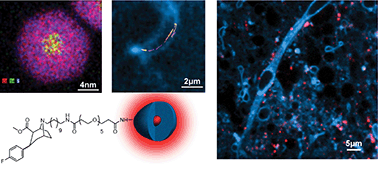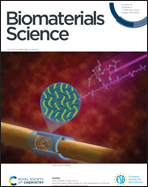Ligand-conjugated quantum dots for fast sub-diffraction protein tracking in acute brain slices†
Abstract
Semiconductor quantum dots (QDs) have demonstrated utility in long-term single particle tracking of membrane proteins in live cells in culture. To extend the superior optical properties of QDs to more physiologically relevant cell platforms, such as acute brain slices, we examine the photophysics of compact ligand-conjugated CdSe/CdS QDs using both ensemble and single particle analysis in brain tissue media. We find that symmetric core passivation is critical for both photostability in oxygenated media and for prolonged single particle imaging in brain slices. We then demonstrate the utility of these QDs by imaging single dopamine transporters in acute brain slices, achieving 20 nm localization precision at 10 Hz frame rates. These findings detail design requirements needed for new QD probes in complex living environments, and open the door to physiologically relevant studies that capture the utility of QD probes in acute brain slices.



 Please wait while we load your content...
Please wait while we load your content...
